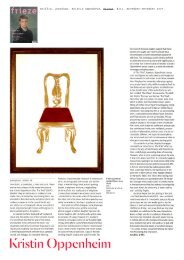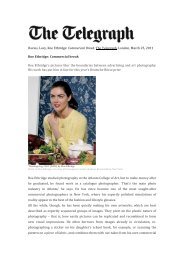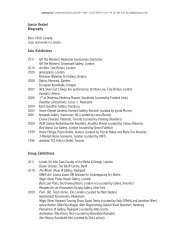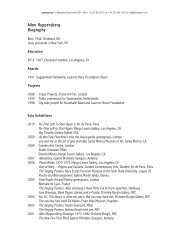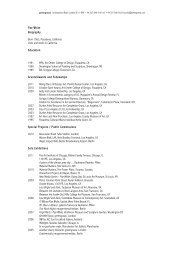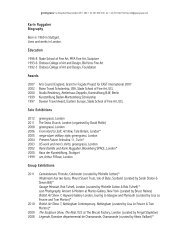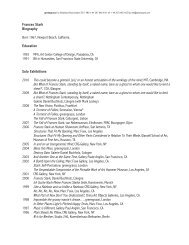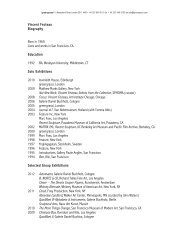Teasdale, Paul, Moyra Davey, Frieze, #44, London ... - Greengrassi
Teasdale, Paul, Moyra Davey, Frieze, #44, London ... - Greengrassi
Teasdale, Paul, Moyra Davey, Frieze, #44, London ... - Greengrassi
Create successful ePaper yourself
Turn your PDF publications into a flip-book with our unique Google optimized e-Paper software.
These memories return to me at a moment when I have been attempting to think about the fate of photography – analogue<br />
photography, the indexical image – in the face of its technological demise, but also potentially of its afterlife; what I have elsewhere<br />
called photography’s ‘expansion’. It seems to me that melancholia has coloured photography’s fate, and it is artists like <strong>Davey</strong> who<br />
embody this relationship most incisively. For here is an artist who seems to have closed off the outside world to become a prowler of<br />
the domestic interior, shut off from the city streets that so long nurtured the hopes of the photographic document. Here is an artist<br />
who seems to emulate Marcel Duchamp, with his laziness and his dust, and one whose artistic process seems an extended languishing<br />
– a flânerie of books and articles and films – an almost passive consumption of other products, in the hope that they might spur an<br />
image or produce the desire to make a photograph. In <strong>Davey</strong>’s video 50 Minutes, begun in the summer of 2003, she interspersed<br />
footage of her own domestic photographs with a deep reflection upon nostalgia, declaring it ‘the intellectual’s guilty pleasure’.<br />
Quoting a critic, she continues: ‘I admit to being disconcerted by a grieving that has been made beautiful. Grief, absence, loss,<br />
longing, wandering, exile, homesickness […] nostalgia is itself a lovely and piercing word.’ In her more recent video, My Necropolis<br />
(2009), the artist fixated on Walter Benjamin, a notoriously saturnine thinker, interspersing images of tombstones in Parisian<br />
cemeteries with footage of the artist’s friends trying to decipher a letter Benjamin once wrote to his friend, the philosopher and<br />
historian Gershom Scholem, in which he mourns for a clock visible from his apartment window – an object he cannot own but to<br />
which he is attached nonetheless, and that he calls ‘a luxury it is difficult to do without’.<br />
‘But,’ objects Josiah McElheny, to whom I am explaining some of my ideas, ‘<strong>Moyra</strong>’s work is not melancholic.’ And that’s just it:<br />
<strong>Davey</strong> shows us that an attachment to loss – of the photographic medium to its own loss – has become a space of possibility for<br />
contemporary photography. Far from a pathological fixation, such melancholia should be understood as a space of opening (an open<br />
wound, if you will). Consider, for example, <strong>Davey</strong>’s series ‘Copperhead’ (1990). Produced during an earlier economic recession (one<br />
to which we can reconnect today), <strong>Davey</strong>’s low-tech images focus on the profile of Abraham Lincoln engraved on the United States<br />
penny – the most devalued piece of American currency. Although almost worthless, the pennies that <strong>Davey</strong> depicts are ‘like’<br />
photographs in many different ways: they are objects of circulation and of use kept close to the body, in wallets and pockets; they are<br />
tokens stamped with their date. They are miniatures, enlarged by the photograph’s innate habit of holding on tight to its objectworld,<br />
progeny of the close-up and the zoom. They are obsolete, throwaway vestiges, but also keepsakes, collectors’ items, the useless<br />
avatars of blind luck or cunning thrift simultaneously. Indeed, each ‘Copperhead’ seems a memorial to photography’s eradication, or<br />
– what amounts to the same thing – its ceaseless dedication to that which is on the verge of disappearance. The photographs capture<br />
the immeasurable variety of the decay of each cast profile upon the penny’s surface, embodying meditations upon loss, erosion, and<br />
the slipping of a thing into the status of detritus.<br />
And yet, in fixating on this image-loss, the ‘Copperhead’ series depicts the penny as a receptor surface, a skin infinitely susceptible to<br />
wounds, gouges and scratches – in other words, a site of contact; an object, like the photograph, endlessly open to receiving the marks<br />
of the world. In recording this, <strong>Davey</strong>’s work mirrors photography in yet another way: these are images of serial objects, replicas, all<br />
given over to the condition of absolute chance and singularity. If each photograph seems an image of disappearance, a cast or imprint<br />
fading away before our eyes, the images’ condition as ‘last photographs’ can also be reversed. It’s as if we are gazing upon photograph<br />
after photograph of what seem to be latent images, a form at the point of its emergence, like a landmass surfacing from the ocean’s<br />
depths, an unknown object blanketed by deep snow. The photographs are at once images of destruction and resurrection, loss and<br />
potential rebirth.<br />
This points to both how and why melancholia has become a tactic, today, in the process of being transvalued by many contemporary<br />
artists. For melancholia, we might say, is above all a form of connection. It is a recalcitrant insistence on attachment, a passionate<br />
embrace, but to an object that is in fact gone; this is a connection staged around loss. Melancholia thus embodies a form of impossible<br />
connection. For photography, at least, this has always been the medium’s central condition, but it is a paradox we can only fully sense<br />
today, as the medium itself has been subjected to its own processes of death. To seize upon connection at the point of loss: Freud<br />
once insisted, in ‘Mourning and Melancholia’ (1915), that melancholia was not only a fixation, but also a ‘taking flight’, a mysterious<br />
passage of the lost object into the ego, so that – just perhaps – ‘love [might] escape [...] abolition’. And so it is with photography<br />
today, as well.<br />
George Baker<br />
George Baker is Associate Professor of Modern and Contemporary Art,<br />
Vice-Chair UCLA, Department of Art History, Los Angeles, USA.




